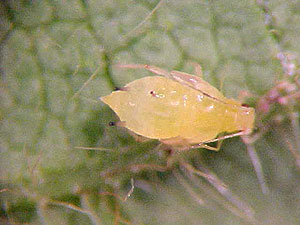|
Audio
Photos
Resources
Your Voice
|
Tiny insects cause big trouble
August 12, 2003
 |
| The soybean aphid was first found in Minnesota three years ago. (Photo courtesy of the University of Minnesota Extension Service) |
Blue Earth County, Minn. — The soybean fields of Blue Earth County look healthy. They're a deep green color. But there's trouble in these fields. Crop consultant Bruce Nowlin is on the hunt for an insect feeding on the fertile crops. Several rows into a soybean field, he stops and plucks a branch off a plant.
"There's probably 50 aphids on that leaf, 75 on that one," says Nowlin. "There's a lot of aphids on that plant."
 | |||
To the eye, the aphids are tiny dots on a green leaf, about the size of a grain of salt. Using a magnifier, Nowlin can see the insects have tapped into the plant's veins. They're sucking out the nutrients which produce the valued beans.
"There's a little pod that's about an inch long, it's got about 20 aphids on it. If we don't do something here, that pod is going to get sucked dry and probably abort," says Nowlin.
Nowlin says this field will be sprayed with insecticide. He says if that's not done, the soybean yield could be reduced 25 percent or more. The aphid is causing problems all across the Midwest. It's believed the bug came to the U.S. from Asia five or six years ago, most likely as eggs attached to imported nursery shrubs.
Since that beginning, the aphid has spread rapidly. It has increased its range as much as 500 miles a year. University of Minnesota entomologist Ken Ostlie says it covers half the country.
 | |||
"It's now found all the way from the Dakotas and Nebraska east into New York, Pennsylvania and Maryland. And all the way south down into Georgia and Mississippi," says Ostlie.
The rapid spread of the aphid is troubling for farmers. But it's also a compelling study in how foreign plants and insects are uniting in this country. The rapid spread of the soybean aphid was boosted by a non-native plant, the buckthorn.
Buckthorn was brought to the U.S. from Europe more than a century ago for use in fencerows. Buckhorn flourished in this country, often crowding out native plants. Soybean aphids lay their eggs in late fall on buckthorn branches. Entomologist Ostlie says the Asian aphids have no problem using a buckthorn with European roots.
"The one that we have here is a different species, but it's very widespread and appears to function just fine as a host," says Ostlie.
 | |||
Back in the Blue Earth County soybean field, crop consultant Bruce Nowlin is watching a ladybug perched on a soybean leaf. Nowlin says the ladybug loves to eat soybean aphids.
"There's a lot of beneficial insects, but not enough. They can't keep up with the populations," says Nowlin.
The ladybug eating the aphids is also an interloper. It comes from Asia. It was deliberately introduced in the U.S. South, where farmers hoped it would destroy the aphids sucking the life out of their pecan trees.
The idea didn't work, but the ladybug slowly spread north. When it hit the Midwest and found the soybean aphid, ladybug numbers exploded. Many Minnesotans are well acquainted with the beetle. It's the ladybug that swarms houses in the fall, trying to gain entry for winter.
Farmers hope eventually the Asian ladybug will hold down aphid numbers, boosting soybean profits. That would complete a homecoming of sorts, since the soybean itself was first cultivated in China.
|
News Headlines
|
Related Subjects
|
